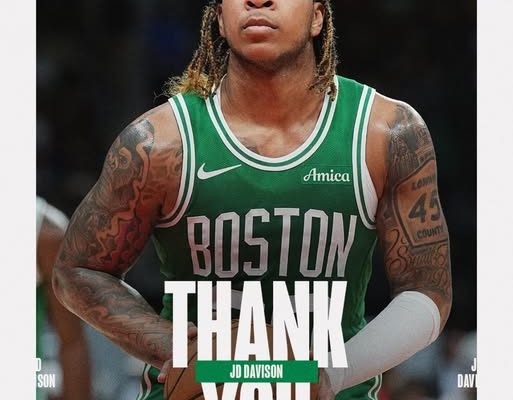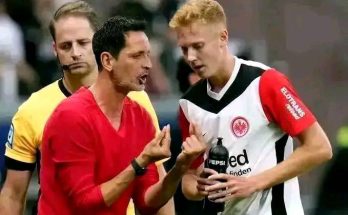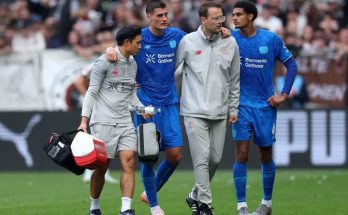The recent news from Causeway Street has sent ripples through the Boston Celtics faithful, a move that, on the surface, might seem minor but speaks volumes about the strategic re-evaluation underway. The official release of their veteran point guard, JD Davison, the reigning G-League MVP, isn’t just about clearing a roster spot; it’s a calculated decision by Brad Stevens and the front office to maximize financial flexibility and reset the team’s trajectory after a 2024-25 season that ended disappointingly in the second round of the playoffs. This isn’t a mere trimming of the fat; it’s a signal that the Celtics are far from content and are actively exploring every avenue to re-establish themselves as genuine championship contenders. The question on every fan’s mind, and indeed, every analyst’s, is what bold roster moves, trade options, and strategic backcourt adjustments are truly on the horizon as the franchise eyes its next championship push? Let’s delve deep into the intricate landscape of the Celtics’ current situation, the ramifications of this release, and the multifaceted possibilities that lie ahead.
The departure of JD Davison, while perhaps surprising given his G-League MVP accolades, was ultimately a pragmatic choice. Davison, a 2022 second-round pick, had reached the end of his two-way contract eligibility and was on a non-guaranteed deal for the upcoming season. Waiving him brings the Celtics below the second apron for now, a crucial maneuver in navigating the NBA’s increasingly stringent collective bargaining agreement rules. This isn’t just about saving money; it’s about unlocking future trade flexibility and the ability to utilize exceptions that become unavailable once a team crosses that punitive second apron. The Celtics are clearly prioritizing financial maneuverability, understanding that in today’s NBA, flexibility is as valuable as any star player. This move, coupled with the prior trades of Jrue Holiday and Kristaps Porzingis that sent out roughly $135 million in salary while taking back only $36 million in Anfernee Simons and Georges Niang, underscores a clear shift. The “retool” is in full swing, even with Jayson Tatum expected to miss most or all of the upcoming season due to an Achilles injury. While a full-blown “rebuild” is being avoided, the focus is squarely on building a sustainable, cost-effective contender for when Tatum returns.
The current Celtics roster, post-Davison, stands at 14 players, leaving one open spot. The backcourt, in particular, will be under immense scrutiny. With Derrick White and Payton Pritchard currently the primary point guard options, and Anfernee Simons also in the fold, there’s both talent and a void. White has proven himself to be an elite two-way guard, capable of facilitating, scoring, and playing tenacious defense. His role will undoubtedly expand in Tatum’s absence, and his efficiency and composure will be paramount. Payton Pritchard, coming off a strong season, has demonstrated his ability to be a microwave scorer and a reliable ball-handler off the bench. The challenge for him will be consistency and adapting to potentially a larger, more varied role. Anfernee Simons, acquired in the Holiday trade, is an intriguing piece. A pure scorer with considerable offensive upside, his fit and defensive integration will be key. The question is whether he can develop into a more well-rounded guard who can initiate offense and defend at a high level, especially without Tatum drawing so much attention.
The open roster spot, while seemingly minor, offers immediate flexibility. The Celtics could sign a veteran free agent, perhaps a point guard with strong defensive instincts or a reliable shooting touch to provide depth and mentorship. The free agent market for point guards in 2025 has some interesting names, though many of the top-tier options like Kyrie Irving, Fred VanVleet, and James Harden have already inked new deals. Still, players like Malcolm Brogdon, Russell Westbrook (though interest has cooled recently due to Ben Simmons’ pending decision), Gary Payton II, Cory Joseph, and Monte Morris are unrestricted free agents who could offer varying degrees of experience and skill sets. The challenge for Boston will be to find a player who aligns with their new financial strategy, likely seeking a veteran minimum or a cost-effective contract. A player like Monte Morris, known for his low turnover rate and solid playmaking, could be an intriguing option if he can be had at a reasonable price. Similarly, a defensive-minded guard like Gary Payton II, if healthy, could provide a much-needed jolt on that end of the floor.
Beyond a simple signing, the trade market is where Brad Stevens can truly make a splash and shape the future of this team. The Celtics still possess valuable assets, including future draft picks and appealing contracts. Their own first-round pick in 2026, 2027, 2028, 2030, and 2031 are all intact, providing significant leverage. They also hold the 28th and 32nd picks in the upcoming 2025 NBA Draft, which could be used to acquire young, cost-controlled talent or as part of a larger trade package. The recent reporting of the Celtics quietly exploring trade-up scenarios in the 2025 NBA Draft underscores their proactive approach. Landing a rotation-level guard on a rookie contract is a strategic priority, given their cap situation. The fact that many early entrants withdrew from the draft to take advantage of NIL opportunities in college has thinned the talent pool in the late first round, making higher picks even more valuable. This could mean packaging their two early second-round picks, or even their late first, to move into the mid-first round where more immediate impact players might be available.
The speculation surrounding potential trades extends to current roster players as well. While Jaylen Brown and Derrick White are considered cornerstones, and the Celtics have a “high price threshold” for them, the reality of the NBA’s financial landscape and Tatum’s injury means nothing is entirely off-limits. Trading either Brown or White would signal a more drastic pivot, but if a truly overwhelming offer were to materialize, Brad Stevens would be remiss not to consider it. More realistically, players like Georges Niang, Sam Hauser, or even Anfernee Simons, if his fit isn’t what they envision, could be moved to optimize the roster. The $22.5 million trade exception generated from the Porzingis deal, which doesn’t expire until next July, is a powerful tool. This exception allows the Celtics to absorb a player’s salary without sending out matching salary, providing immense flexibility for acquiring talent via trade. This could be used to bring in a veteran who provides immediate impact or a player with a longer-term, value contract.
When considering trade targets, the Celtics must evaluate their needs across the board, not just at point guard. While the backcourt is a focus, the frontcourt also has questions, particularly with the departures of Kristaps Porzingis and Al Horford (who is reportedly signing with the Warriors). While Neemias Queta and Luka Garza are on the roster, they are largely unproven commodities. The Celtics will need reliable big-man depth, capable of rebounding, protecting the rim, and providing some offensive punch. Players like Domantas Sabonis or Nikola Vucevic have been mentioned in speculative trade rumors, though their contracts and the assets required might be too significant for the Celtics’ current financial strategy. A more realistic target might be a versatile, defensive-minded forward who can play small-ball five or provide energy and rebounding off the bench.
The strategic backcourt adjustments will go beyond personnel. With Tatum sidelined, the offensive burden will fall heavily on Jaylen Brown, Derrick White, and Anfernee Simons. Coach Joe Mazzulla will need to be creative in designing an offense that leverages their strengths. Summer League observations indicated a potential shift towards a more aggressive defensive scheme, utilizing the team’s length and athleticism to force turnovers. Offensively, there was an emphasis on more off-ball cutting, flare screens, and general movement. This could be a concerted effort to generate easier baskets and create spacing, especially given the expected lack of traditional floor spacing from the frontcourt. Without a dominant ball-handler like Tatum creating gravity, the Celtics will need to be more democratic in their offensive approach, relying on quick decisions, constant motion, and opportunistic playmaking from multiple players.
The recruitment of Damian Lillard by Jayson Tatum, despite both players facing long Achilles rehabs and being sidelined for the upcoming season, is a fascinating subplot and speaks to the long-term vision. While Lillard would be 35 and on the back nine of his career when he potentially returns in 2026-27, his pure scoring and playmaking abilities, even at that age, could be a significant addition alongside a healthy Tatum and Brown. This type of move, however, would be for the next championship window, not the immediate future, and would depend heavily on Lillard’s willingness to potentially take a veteran’s minimum or mid-level exception. It highlights the ambition of the organization and its star players to continually attract top-tier talent.
The path to the next championship push is multi-layered and will require patience and astute decision-making from Brad Stevens. The immediate focus will be on navigating the 2025-26 season without Jayson Tatum. This period, while challenging, can also serve as a crucial developmental year for younger players and an opportunity for established veterans like Jaylen Brown and Derrick White to shoulder greater responsibilities. The waiver of JD Davison is a foundational step in creating the financial and roster flexibility needed to make bolder moves.
Looking ahead, the Celtics will have several key decisions to make. Beyond potential trades and free agent signings, the development of their existing young talent is paramount. Players like Jordan Walsh and Baylor Scheierman, along with any incoming draft picks, will need to show significant growth to contribute meaningfully to a championship-contending team. The Celtics’ ability to identify and develop these cost-controlled assets will be crucial in managing their luxury tax bill in future seasons.
The ultimate goal, as always, is Banner 18. The immediate aftermath of the 2024-25 season and the subsequent roster moves clearly indicate that the Celtics are not content with past successes. They are taking a long, hard look at their roster, their financial commitments, and their strategic approach. The release of JD Davison, while a small piece of the puzzle, is a microcosm of this larger strategy: shed non-essential costs, create flexibility, and position the franchise for a renewed championship assault. The road ahead will be challenging, especially without Tatum, but the underlying message is clear: the Boston Celtics are reloading, not rebuilding, and they are preparing for their next big push to the top of the NBA. The ensuing months will be a masterclass in front-office maneuvering, as every decision, no matter how small, will contribute to the grand design of bringing another championship banner to the TD Garden rafters. The pressure is on, and the Green Team is watching with bated breath to see how Brad Stevens crafts the next iteration of a championship contender.



